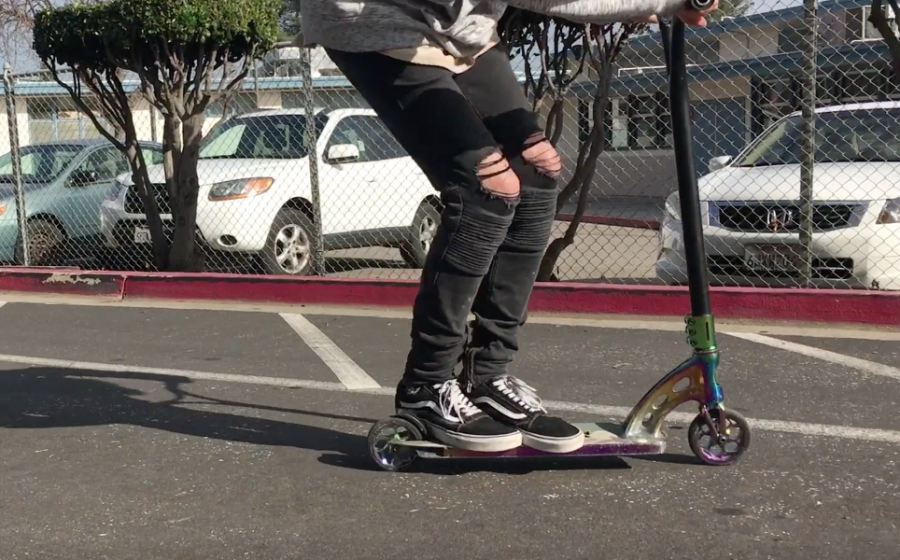Scootering back into fashion: The rise of scooters on the MVHS campus
January 22, 2018
Standing on the edge of a 20-foot-bowl at Santa Clara’s Cabrillo skate park, sophomore Joseph Balje shifted his feet on his skateboard, getting ready for the drop-in. But as he pushed off, something didn’t feel right. Instead of landing the trick, he landed on his face — causing two chipped teeth, a cut lip and a concussion. When recovering from the injury, Balje realized he needed a safer mode of both transportation and fun, and ultimately decided on the scooter.
Although he got his first Razor scooter when he was only five years old, doing tricks on a scooter first piqued Balje’s interest when he came across YouTube videos of people doing tricks on their scooters. He decided to go back to the skatepark to learn how to do them himself. Two years later, he can still be found at the skatepark learning something new on his scooter.
“I scooter around school because it’s how I get to school, and also I like doing tricks because it’s fun [and] not a lot of people do it so it’s more noticeable,” Balje said.
Bajle does a trick on his neo chrome scooter where the scooter turns 360 degrees underneath him.
Whereas Balje started scootering because of his interest in learning tricks, senior Sherwin Zhang just needed a fast way to get to school. Scootering cut his walking time by a third, resulting in a five to six minute commute. He started in his freshman year, when he got his first scooter, all the way to the first month of senior year, when he finally got a car.
Although Zhang no longer scooters, he explains that he still sees scooters around MVHS and even some colleges, making scootering seem more popular.
“There’s a lot of these big wheel scooters being made,” Zhang said. “They’re cheap and they’re getting into fashion for some reason. Some people don’t think they’re as weird anymore, and that’s pretty cool I guess.”
Balje also agrees that scooters are becoming more popular and even trendy. The growing popularity of Youtubers with scooter-focused channels, could be a major part of why scootering is being taken more seriously as both a statement and a mode of transportation according to Balje. For example, Ryan Williams, Balje’s biggest inspiration, has over 680,000 subscribers on Youtube, and was even the reason Balje purchased his current scooter, a neo chrome trick scooter.
After having a Razor scooter for five years prior to owning his trick scooter, Balje knows the difference between regular Razor scooters and trick scooters.
“Razors are more for getting around and they’re kind of janky,” Balje said. “They’re really rattly and they’re not really good for tricks because the bars aren’t sturdy and it’s kind of too small and light to do anything.”
Bajle does a “180” trick where he turns the scooter along with himself in the air.
Razor-brand scooters may not be ideal for tricks, but they are good for getting around — something junior Prateek Kaushik is grateful for when he’s running late. Kaushik’s most recent Barbie scooter was gifted to him by his friend after his previous two were stolen.
“[I started scootering] freshman year,” Kaushik said. “I had a blue razor scooter, but then it got stolen and I was really sad. Then I got my sister’s pink razor scooter and that got stolen too so I sort of took a sabbatical for a year.”
After he stopped scootering, he realized that he missed the fun he had while scootering and was constantly late to school, so now he scooters when he’s late or in the mood.
Though Kaushik, Balje and Zhang’s reasons for scootering are different, the attachment that they shared for the often-mocked mode of transportation is the same. Though the trend may die out, scooters have remained a pinnacle of many childhoods, and for some, a tool of fun and time management. In the meantime, Kaushik has a message for those who disagree.
“Don’t steal my scooter please,” Kaushik said. “It got stolen like three times.”



















